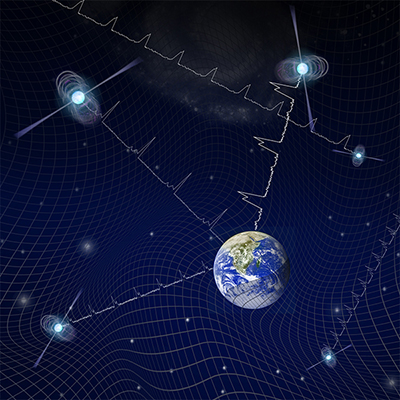The discovery of gravitational waves in 2015 revolutionized astronomy by opening up an entirely new way of studying extreme cosmic phenomena. Now researchers have reported the first evidence for a previously theorized but never-before-seen kind of low-frequency gravitational wave. The evidence comes in the form of a timing discrepancies detected in pulses of radio signals emanating from cosmic objects called pulsars. Rapidly spinning remnants of massive stars, pulsars send out beams of radiation as they rotate, similar to a lighthouse. Astrophysicists have long sought to leverage the clock-like precision of pulsars' pulse patterns to register miniscule changes in Earth's position caused by gravitational waves as the waves stretch and compress spacetime. These tiny changes in position would manifest as discrepancies in the timing of the pulses' arrival. See also: Pulsar; Radiation; Spacetime; Star

Observations of 47 pulsars stretching back—in some cases a dozen years—have shown hints of these timing discrepancies in nearly all the pulsars surveyed. Researchers isolated this discrepancy signature by subtracting all known sources of natural variation in pulsar timing. These observations were obtained by two of the largest radio telescopes in the world—namely, the Green Bank Telescope in West Virginia, United States, and the Arecibo Observatory in Puerto Rico (which catastrophically collapsed in late 2020). These telescopes have worked in concert to comprise the North American Nanohertz Observatory for Gravitational Waves (NANOGrav), part of the International Pulsar Timing Array that is pooling data from the largest radio telescopes in the world to search for low-frequency gravitational waves. See also: Astronomical observatory; Radio astronomy
Low-frequency gravitational radiation would stand in contrast to the high-frequency waves first detected by the Laser Interferometer Gravitational-wave Observatory (LIGO) instrument in 2015, which bore out an original prediction made by Albert Einstein a century prior in his theory of general relativity. Those high-frequency waves are generated by mergers of black holes with tens of times the Sun's mass, or alternatively by mergers of neutron stars, or neutron stars and black holes. The sources of low-frequency waves possibly identified by NANOgrav would instead be supermassive black holes. Such objects possess millions or even billions of times the Sun's mass. Sometimes found as pairs in cores of galaxies, supermassive black holes are expected to emit gravitational radiation as they rotate about each other over the course of hundreds of millions of years, contributing to a universe-spanning background of low-frequency waves. If confirmed by additional observations, these low-frequency waves would represent a key expansion of gravitational-wave astronomy, which holds great promise for delivering novel insights into astrophysical phenomena that cannot be achieved through electromagnetic radiation used in traditional astronomy. See also: Black hole; Electromagnetic radiation; LIGO (Laser Interferometer Gravitational-wave Observatory); Neutron star





